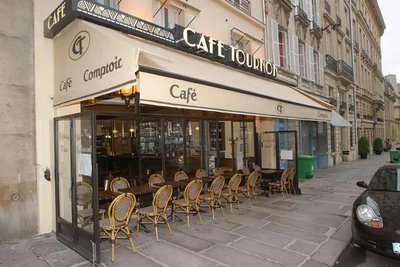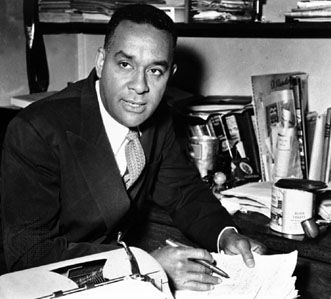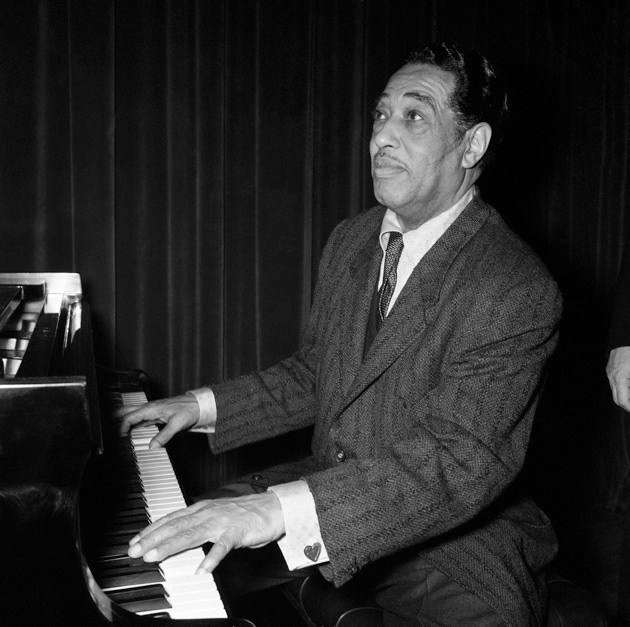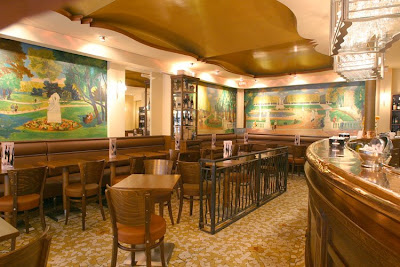African-Americans and a Parisian Café

During Black
History Month each February, several renowned figures and events come to mind:
Martin Luther King, Jr.’s “I Have a Dream” speech, of course; also Harriet
Tubman’s work as a “conductor” on the Underground Railroad; and Jackie
Robinson’s debut into major league baseball. Along with many others. But another
historical footnote that is part and parcel of African-American heritage occurred
in Paris in the 40s and 50s. In that era, the city served as a refuge for those
hoping to escape Jim Crow laws and the racial torment they experienced at home.
Regardless of their race, they were welcomed everywhere—in hotels, restaurants,
universities. One café in particular located in the 6th
arrondissement is especially significant when we take a look back. Le Tournon, still
going strong today as a chic wine bar and bistro, first opened for business in
the 1930s. A decade or so later, the establishment became a kind of a second
home for a number of big-name African-American writers, artists, and musicians.
Expats gathered there to share ideas, discuss and sometimes argue over
important questions of the day, and simply be themselves. If that terrace and those
frescoed walls could talk…

Le Tournon,
situated on a street of the same name, really took off as an African-American intellectual
and artistic center in 1948 when Richard Wright moved into an apartment with
his family on the nearby rue Monsieur-le-Prince. He became such a faithful client
of this neighborhood café that he called it his
“office” and his friends started referring to it as “Dick’s place.” The
author of Native Son and Black Boy spent many hours in that small
space just north of the Luxembourg Gardens chatting with friends, drinking
coffee, and playing pinball. To Wright, the Tournon was the Parisian “black
church” for him and his friends.
 And what
remarkable friends they were. For one, there was James Baldwin. “Jimmy,” as he
was known, loved Paris, a city where he finally felt “free of the crutches of
race.” He had received a grant to work in the French capital through the
efforts of Dick Wright, but the two men clashed at times over philosophical
issues in their writing. Baldwin and abstract expressionist artist Beauford
Delaney patronized the Tournon but, in Delaney’s words, found the expat company
there “too macho and not very friendly”—especially toward gay men like themselves.
Baldwin sought out other venues including the Café de Flore, 10 minutes away,
to do revisions on his first novel Go
Tell It On the Mountain.
And what
remarkable friends they were. For one, there was James Baldwin. “Jimmy,” as he
was known, loved Paris, a city where he finally felt “free of the crutches of
race.” He had received a grant to work in the French capital through the
efforts of Dick Wright, but the two men clashed at times over philosophical
issues in their writing. Baldwin and abstract expressionist artist Beauford
Delaney patronized the Tournon but, in Delaney’s words, found the expat company
there “too macho and not very friendly”—especially toward gay men like themselves.
Baldwin sought out other venues including the Café de Flore, 10 minutes away,
to do revisions on his first novel Go
Tell It On the Mountain. In the early 1950s a new writer joined in the African-American glory
days at the Tournon: Chester Himes. Perhaps an unfamiliar name to most modern-day
Americans, the Missouri native came for a one-month stay in the capital but
remained in the area for the rest of his life. Himes had several publications under
his belt when he arrived but wisely took the advice of a Parisian book editor
at Gallimard and began writing mysteries. The author of the Harlem Detective
Series, he would become known as “the father of Black American crime writing” and,
as he put it, was “more famous in Paris than any black American who had ever
lived.” He felt “completely free” in the city because, even though it was far
from a utopia, “Here a Negro is a human being.”
In the early 1950s a new writer joined in the African-American glory
days at the Tournon: Chester Himes. Perhaps an unfamiliar name to most modern-day
Americans, the Missouri native came for a one-month stay in the capital but
remained in the area for the rest of his life. Himes had several publications under
his belt when he arrived but wisely took the advice of a Parisian book editor
at Gallimard and began writing mysteries. The author of the Harlem Detective
Series, he would become known as “the father of Black American crime writing” and,
as he put it, was “more famous in Paris than any black American who had ever
lived.” He felt “completely free” in the city because, even though it was far
from a utopia, “Here a Negro is a human being.”  But it was not just members of the African-American literary and artistic world who gathered at this Left Bank café. A small stage set up at the Tournon was where
Duke Ellington and some of the guys in his band introduced jazz to Parisians.
This eventually led to an unbridled passion on the part of the French for the
new style of music and perhaps contributed to the positive reception of other
African-Americans in the capital city. Ellington’s band members too were well
aware of the lack of racism in Paris. Supposedly, at the end of a tour in 1950
many of them were reluctant to return home.So, if you're ever in Paris and in search of an American landmark, drop in at the Tournon and raise a glass to a number of our famous compatriots of the past. Read more about Wright, Baldwin, Himes, Ellington, and the Tournon in my recent book, Pilgrimage to Paris: The Cheapo Snob's Guide to the City and the Americans Who Lived There.
But it was not just members of the African-American literary and artistic world who gathered at this Left Bank café. A small stage set up at the Tournon was where
Duke Ellington and some of the guys in his band introduced jazz to Parisians.
This eventually led to an unbridled passion on the part of the French for the
new style of music and perhaps contributed to the positive reception of other
African-Americans in the capital city. Ellington’s band members too were well
aware of the lack of racism in Paris. Supposedly, at the end of a tour in 1950
many of them were reluctant to return home.So, if you're ever in Paris and in search of an American landmark, drop in at the Tournon and raise a glass to a number of our famous compatriots of the past. Read more about Wright, Baldwin, Himes, Ellington, and the Tournon in my recent book, Pilgrimage to Paris: The Cheapo Snob's Guide to the City and the Americans Who Lived There. 
Recent Comments